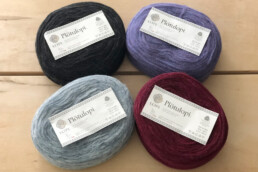Of Sheep and Wool
In the north, sheep live outside most of the time, in regions where the climate can be extremely harsh. Especially the old breeds develop a dense undercoat, which is mixed with the upper wool layer and spun into yarn. This yarn is extremely robust and weatherproof and ensures a pleasant exchange of warmth.

The wool from Icelandic sheep is probably best known in our area.
From Spring til the time of “Réttir” in Autumn, these animals are out in nature, during summer also in the highlands, where they roam freely. It is quite possible that they experience all 4 seasons in a single day – a fact that is also reflected in the quality and peculiarity of their wool.


More sheep (native breeds):
- Gammlenorsk Spælsau – an old Norwegian short-tailed breed.
- Shetland sheep – an old, rather small short-tailed breed originating from the Shetland Islands. A peculiarity of this breed are the different natural colourings.
- Manx Loaghtan – an old rare and nearly extinct breed, native to the Isle of Man (UK). Manx Loaghtan have 4 to sometimes even 6 horns
Wool care:
Iceland wool as well as shetland wool is “self-cleaning” and should not be washed if possible.
- Air the jumper regularly, preferably in foggy or humid weather
- Hand wash in lukewarm water (max. 30°C)
- Wrap in a cloth and squeeze gently – do not wring out!
- Slightly pull into shape and let dry lying flat
Iceland wool is weatherproof in snow and light rain but not 100% windproof. In strong winds, a light wind stopper is often worn as extra layer under the jumper. By wearing, the wool becomes slightly denser and adapts to the body


